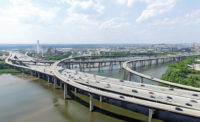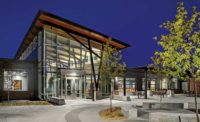Chickasaw Nation Cultural Center and National Recreation Bridge
Sulphur, Okla.
Best Project
Owner: Chickasaw Nation
Lead Design Firm: Tetra Tech
General Contractor: Manhattan Road & Bridge Co.
Civil Engineer: Ellen Stevens
Geotechnical Engineer: Kleinfelder
Subcontractors: Customrock Formliner
Suppliers: Advantage Terrafab LLC; Diamondback Steel Co.; Dolese Bros. Co.; Hanson, Mid-America Rigging; W&W AFCO Steel
This cable-stayed suspension bridge was a joint effort between the Chickasaw Nation and the National Park Service. It provides pedestrians and cyclists with a scenic crossing of Rock Creek from the National Recreation Area to the Cultural Center.
The final design is a 195-ft-long, single-span suspended truss supported by two opposing 34-ft concrete pier towers, cast in place and form lined to match the natural stone. Other features include retaining-wall abutments, anchor blocks, decorative-steel handrail and a precast concrete deck and approaches. In all, the assembly required 25 tons of structural steel with 11 “fish-belly” welded floor beams.
Assembled off site, the bridge was shipped as three 65-ft sections with two bolted field splices. The fabrication of the floor beams and stringers required great precision so that the lower stringer would connect to the beams while maintaining a consistent camber profile with the upper stringers.
To maintain a connection with the natural surroundings, a slender Vierendeel-attributed truss, or spinal beam, was designed for the main section. The beam’s transverse ribs were constructed of 6-in. structural tubes bent at a 2-ft, 4-in. radius.
The greatest fabrication challenge was forming the intermediate brace ribs to the specified radius without collapsing the hollow structural-steel trusses. An independent specialist helped the team work out the final fabricated-truss structure, which required only six bolted field connections and three stringers at each of the two field splices, using a minimal number of bolts at each connection.
Completed in November 2016, the bridge was formally dedicated on April 18, 2017.
Related Article: Diverse Projects Named Region’s Best







Post a comment to this article
Report Abusive Comment